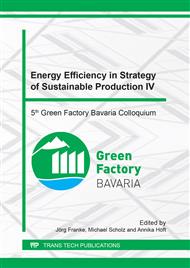[1]
W. Zapka, W. Voit, I. Reinholdwird: Drucken jenseits der Farbe, Elektronik 12/2013, pp.34-39.
Google Scholar
[2]
M. Reichenberger, J. Hörber, J. Franke, W. Jillek: Functionalization of Thermoplastics using Inkjet- and Aerosoljet-Printing Technologies, Proceedings of the 10th International Congress Molded Interconnect Devices (MID), (2012).
Google Scholar
[3]
K. Gilleo: Polymer Thickfilm: New York, Van Nostrand Reinhold, (1996).
Google Scholar
[4]
J. Bahr, O. Kravchuk, M. Reichenberger: Investigation of Different Sintering Methods on Ink-Jet-Printed Conductive Structures, Applied Mechanics and Materials, Vol. 856, pp.217-223, (2016).
DOI: 10.4028/www.scientific.net/amm.856.217
Google Scholar
[5]
J. Bahr, J. Schirmer, M. Reichenberger: Functional printing of silver nano ink on injection molded polymeric substrates, Applied Mechanics and Materials, Vol. 805, pp.147-153, (2015).
DOI: 10.4028/www.scientific.net/amm.805.139
Google Scholar
[6]
J. Schirmer, J. Bahr, M. Reichenberger: Evaluation of Application Limits for Inkjet-printed MIDs, Proceedings of the 12th International Congress Molded Interconnect Devices (MID), (2016).
DOI: 10.1109/icmid.2016.7738931
Google Scholar
[7]
M. Luniak: Charakterisierung der Polymeren Dickschichttechnik für den Einsatz in der Mikroelektronik, Dissertation Dresden, Technische Universität, (2008).
Google Scholar
[8]
G. Nisato: Organic and Printed Electronics - Fundamentals and Applications, CRC Press, Taylor & Francis Group, (2016).
Google Scholar
[9]
A. Wimmer et al.: Manufacturing of Sandwich Structures for the Integration of Electronics in In Mold Labelling Components, Proceedings of the 12th International Congress Molded Interconnect Devices (MID), 2016, pp.1-4.
DOI: 10.1109/icmid.2016.7738922
Google Scholar
[10]
J. Hörber, S. Härter, J. Franke: Processing and Qualification of Polymer Based Pastes in Electroncis Production, Physics Procedia 5 (2010), pp.727-733.
DOI: 10.1016/j.phpro.2010.08.105
Google Scholar
[11]
T. Suonurmi: Component Mounting on Stretchable Substrate in Wearable Electronics Applications, Master Thesis, Tampere University of Technology, (2016).
Google Scholar
[12]
J. Hörber et al.: Approaches for additive manufacturing of 3D electronic applications, Procedia CIRP 17, 2014, pp.806-811.
DOI: 10.1016/j.procir.2014.01.090
Google Scholar
[13]
B. Salam, B.K. Lok: Solderability and Reliability of Printed Electronics, 2008 15th International Symposium on the Physical and Failure Analysis of Integrated Circuits, Singapore, 2008, pp.1-4.
DOI: 10.1109/ipfa.2008.4588211
Google Scholar
[14]
Richard L. Chaney et al.: Advances in Flexible Hybrid Electronics Reliability, 2017 IEEE Workshop on Microelectronics and Electron Devices (WMED), Boise, ID, 2017, pp.1-4.
DOI: 10.1109/wmed.2017.7916924
Google Scholar
[15]
Xiaotian Li et al.: Soldering surface mount components on screen-printed Ag patterns on paper and polyimide substrates for hybrid printed electronics, Flexible and Printed Electronics, Volume 3, Number 1, (2018).
DOI: 10.1088/2058-8585/aa9dc7
Google Scholar
[16]
DIN EN ISO 2409:2013-06: Paints and varnishes - Cross-cut test (ISO 2409:2013).
Google Scholar
[17]
R. Luchs: Einsatzmöglichkeiten leitender Klebstoffe zur zuverlässigen Kontaktierung elektro-nischer Bauelemente in der SMT, Meisenbach Verlag, Bamberg,(2003).
Google Scholar
[18]
I. Maus et al.: Characterization of epoxy based highly filled die attach materials in microelec-tronics, 18th International Conference on Thermal, Mechanical and Multi-Physics Simulation and Experiments in Microelectronics and Microsystems (EuroSimE), Dresden, 2017, pp.1-7.
DOI: 10.1109/eurosime.2017.7926237
Google Scholar
[19]
U. Eitner et al.: Characterization of electrically conductive adhesives, Energy Procedia, Volume 27, 2012, pp.676-679.
DOI: 10.1016/j.egypro.2012.07.128
Google Scholar


